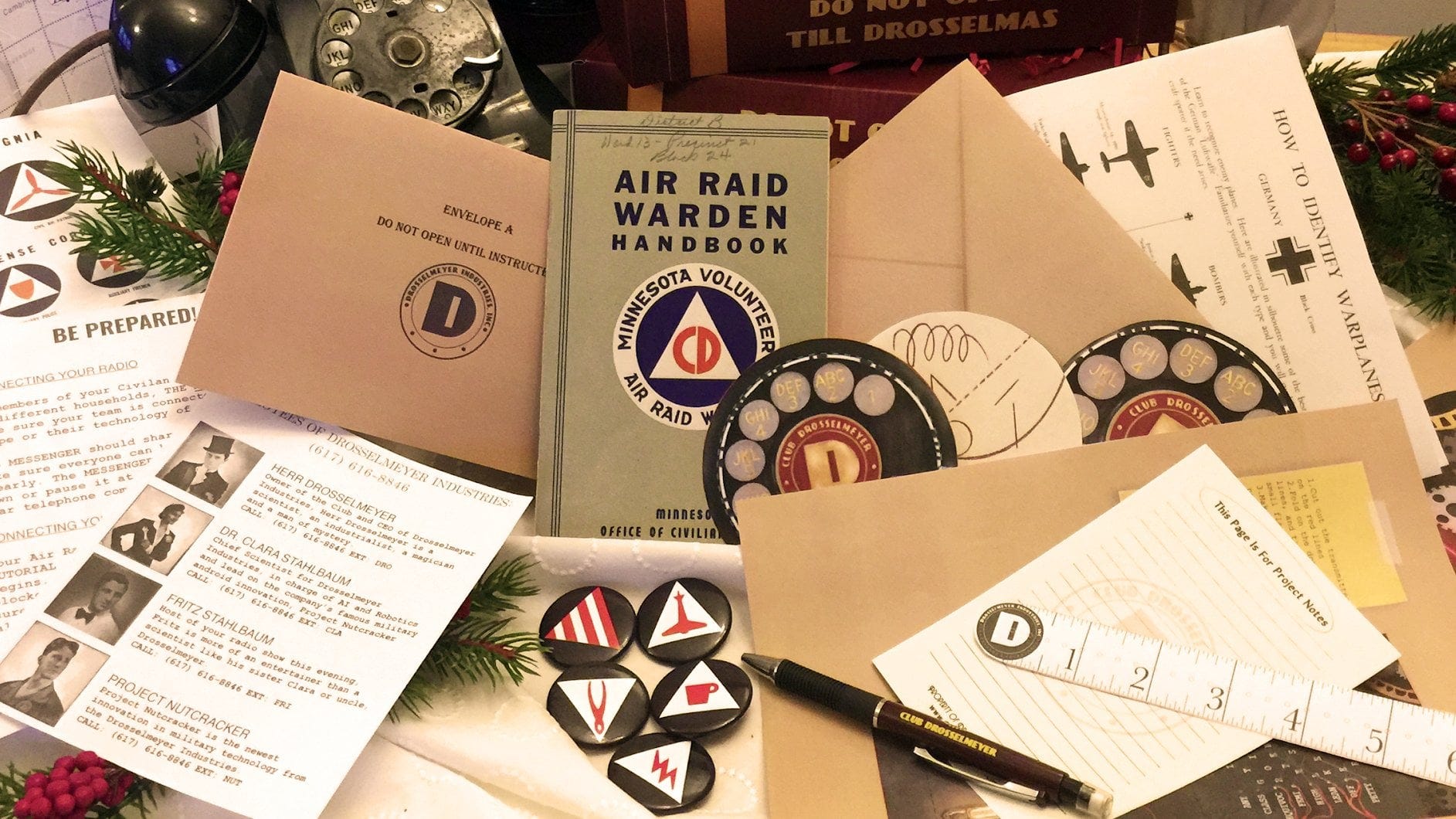
Multiple scientific studies over the years have dispelled the myth that true multitasking exists. The human mind simply cannot do multiple things at once; instead, we switch back and forth very quickly between tasks when we attempt to do more than one at a time. Efficiency can drop up to 40% when someone is “multitasking.” Our poor brains literally shut out other stimuli when choosing what information to process, while we also become more susceptible to distractions, during this process. And, unfortunately, this constant switching, when measured, also tends to make us worse at our goals.
Which is probably why at the end of my experience with Club Drosselmeyer 1943, I felt completely spent.
To the point where NoPro’s East Coast Curator at Large Blake Weil mentioned, “You… look exhausted,” during the afterparty.
Indeed, I was one tired Air Raid Warden.
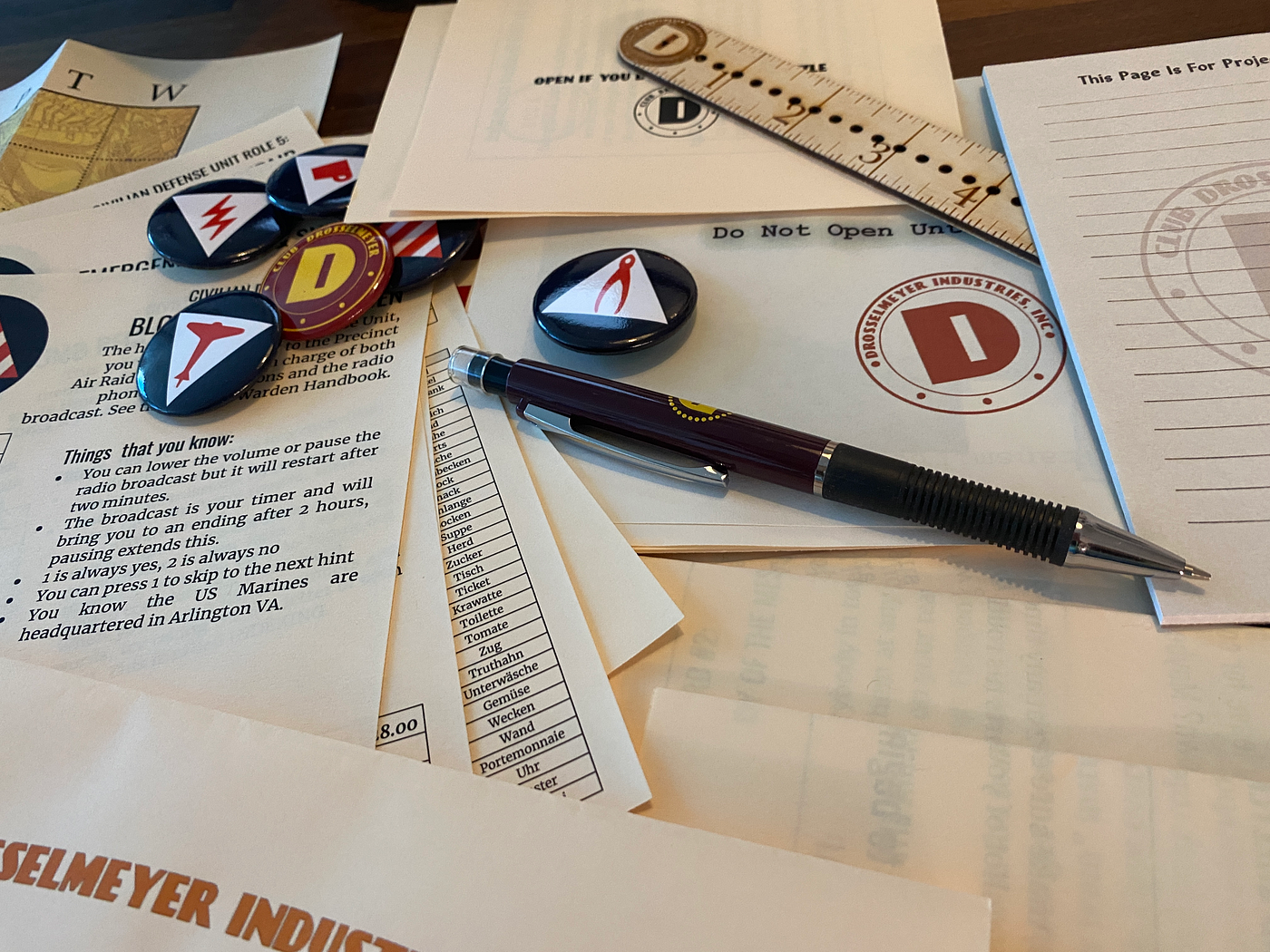
Club Drosselmeyer, Green Door Labs’ annual big band, swing dance party which also doubles as a puzzle-solving-with-actors holiday experience has been converted into a remote, digital experience with a multitude of components in 2020. Players of Club Drosselmeyer this year can either order a set of puzzle components to be shipped to them, or purchase a print-and-play PDF of the same content (nearly 40 pages of materials). Club Drosselmeyer 1943 works best if players form small teams — aka “Civilian Defense Units” — of five or more people and assign roles, although this isn’t exactly clear until you open up the print materials and start reading. The pre-purchase web site doesn’t specifically recommend forming a team, which implies that this experience might be something that could possible be solo or with a team of two. (But there’s simply too much going on during the experience for me to recommend that.) I, too, was unaware I needed to assemble a team until NoPro Correspondent Cara Mandel told me to do so beforehand; luckily, I ended up playing with five distributed households from the NoPro staff. I’ll also note that Club Drosselmeyer 1943 should be played in real time over the course of two hours. And it helps to set aside 20 minutes or so beforehand to complete the tutorials, gather all your print collateral, and assign roles among your team before the timer starts. We actually found that the five “roles” in the game are fairly malleable and flexible in this game, save for the Air Raid Warden, who ends up the de facto leader of the group.
And, guess what? That ended up being me.
(Significant spoilers follow.)
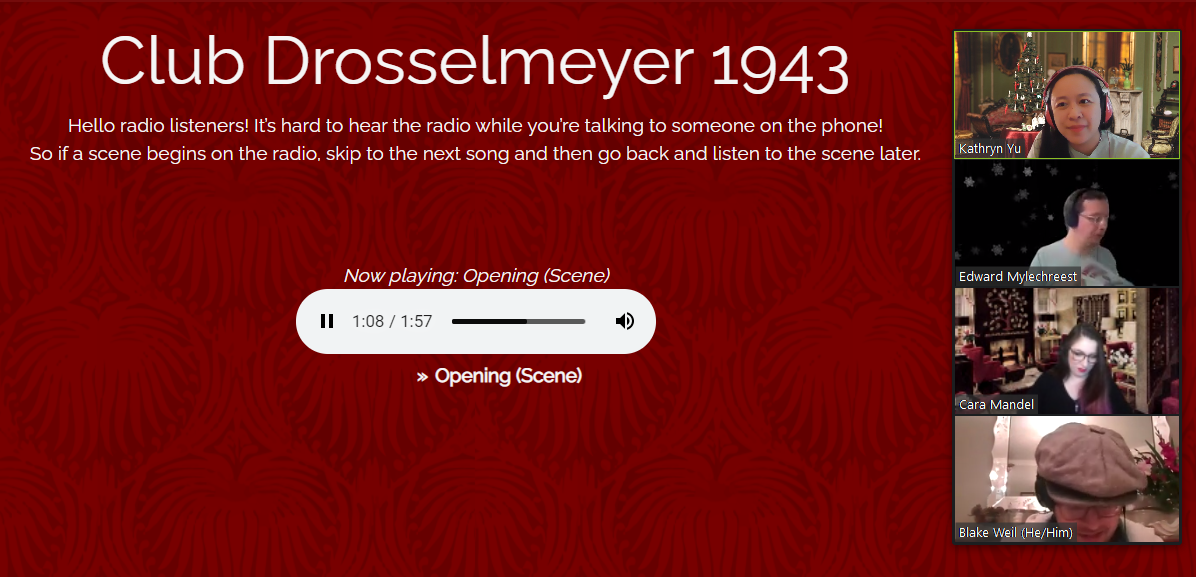
The Air Raid Warden for each Club Drosselmeyer 1943 team is in charge of tuning into the show’s official radio broadcast (available on a password-protected, custom-built web site) and sharing both their screen and computer sound (using a web conferencing technology like Zoom) so that the others can hear the radio show. In addition to sharing their audio, the Warden interacts with the production’s “switchboard” by dialing into one of a few provided telephone numbers and entering in solutions to puzzles via dial pad. The puzzles are the only non-digital component but the show’s backend engine tracks where your team “is” in the story: what puzzles you’ve solved and what narrative branches you’ve taken. And — rather impressively — it adjusts both the phone tree content and radio broadcast content appropriately to the paths you’ve taken.
As NoPro NYC Correspondent Edward Mylechreest observed, “Having our screen adapt and change in real time based on our decisions, was a simple necessity for making me feel fully in the world.” Similarly, NoPro LA correspondent Laura Hess said, “It felt like I was dropping into this comprehensive and cohesive world from a design standpoint. I genuinely felt immersed in the world of Club Drosselmeyer.”
Still, I won’t lie: the Club Drosselmeyer 1943 experience is a lot to manage at once.
As the Air Raid Warden, I found that using my left hand for my iPhone, my right hand for my mouse to control Zoom and the Drosselmeyer radio player, while placing the paper puzzle pieces underneath my laptop stand was a somewhat successful configuration. This was the only way I found I could still participate in the puzzle-solving while running all the show’s digital components for my team. I’ll also note that the Air Raid Warden really needs four or five hands to do what they need to do… or to abstain from puzzle-solving a fair bit of the time. Personally, I would also love to see a version of this game with an intermission — two hours is a long time to puzzle without breaks — and the ability to let another person take on the role of Air Raid Warden, say, in the second half, or to split their duties among multiple people.

The full Drosselmeyer experience — which already spans a web site, multiple phone calls, printed puzzles, and the aforementioned Zoom call for remote teams, all conducted with a two hour timer in place — also allows for a potential upgrade with interactions involving live actors. These actors are the same ones whose voices you hear in the phone tree; recorded versions of them are available by putting in the proper extension when the “switchboard operator” picks up. And, on occasion, after reaching the end of a quest, a performer may call your team directly and confirm the team’s success, while dropping a bit of plot here and there. Or an actor may call you and check up on your progress if it seems that your team may be in need of a hint, which is a nice touch. This means there are more than a few moments where it’s unclear if you’re talking to a live human or a recording of that same live human. I found this mixing of the recorded audio elements and live actor elements to be exceedingly clever on the creative team’s part. (Sidebar: Herr Drosselmeyer, I apologize for nearly biting your head off when you rang, as I’d simply assumed you were a machine!) Part of the Drosselmeyer set up process also involves giving the show your name and phone number, so don’t be startled when a performer addresses you by name.
If you’re still with me and thinking that this all sounds like a lot, trust me, it is.
Someone could play Club Drosselmeyer 1943 multiple times and make different choices each time, receive one of several different endings, and possibly never interact with a live performer. After our single playthrough, I found I had several unopened envelopes with puzzles we had never started due to the vast amount of content in the Club Drosselmeyer 1943 experience. Part of the design seems to be to provide the players with an overwhelming amount of stuff to choose from which can drive multiple playthroughs later. Even so, our FOMO-fueled team still kept cramming in as much content as possible within our allowed two hours.
Some people may enjoy this sort of layered, madcap gaming immensely. I can see its appeal if you aren’t stuck as Air Raid Warden for the entire two hours, especially if you already know you want to play through Drosselmeyer more than once. And I assume the experience gets easier on a subsequent playthrough, once you’re up to speed on how it all works together. I personally found the amount of task- and context-switching during my own experience somewhat dissatisfying.
Get Kathryn Yu’s stories in your inbox
Join Medium for free to get updates from this writer.
SubscribeSubscribe
The era-appropriate switchboard, radio show, and puzzles themselves were, for the most part, pleasing and well-executed. Truly, each separate part of the show was of very high quality, especially if considered in isolation. There’s a delightful play-along-at-home card trick during the start of the radio show. The big band music was well-chosen and appropriate to the theme. My team enjoyed the variety of the different puzzles and difficulty level of the challenges we encountered, as well as their tactile, physical nature, even if there were some small mishaps along the way. As a team, we enjoyed making decisions which altered the narrative of our game; it felt like we were making real choices and those choices mattered in the story. And being able to improvise conversations with live performers in the context of a rich, detailed world is always a delight. But the glue that held these disparate components together felt both unforgiving and fragile at the same time; that is to say, the interface layer of the Club Drosselmeyer 1943 remote experience often got in its own way.
Take the following scenario. You’re in the midst of three conversations happening simultaneously: one with your teammates over Zoom who are shouting at the person on the telephone, even though that “person” can’t hear them and may actually be a recording; one with the phone tree as said cell phone is being held up to a laptop microphone while on speaker mode; and a recorded skit between two characters as part of a radio broadcast which you’re constantly turning up or down dependent upon the context. It’s a lot of different audio sources for the mind to process at once. This is further complicated by the fact that while the radio interface does allow users to temporarily pause the broadcast, the custom player they’ve built resumes playback on its own after two minutes. Therefore, the radio may suddenly start playing dialog or background music precisely when you don’t want it to play.

My team found that this “auto-unpause” feature interrupted our flow multiple times to the point where we began to disregard the radio in the latter half of the game. And as Air Raid Warden, I also found the only-8-pixels-tall volume slider in the custom audio player to be quite difficult to use, particularly when under pressure as my team would shout at me, “Can you turn down the music again?!” or “Ack, pause! Pause!” (That is, if there was a volume slider available that I could even see, because it didn’t show up for me in Safari, only in Chrome, and only upon mouseover.)
I also found that some of the Drosselmeyer switchboard prompts, in an attempt to sound more human, were slightly vague and could have been interpreted multiple ways. The in-game phone tree instructions differed significantly enough from the tutorial’s phrasing to be confusing. So only through trial and error did we discover that an ambiguously worded phrase was attempting to provide us three separate options, not just two. Incorrect answers also meant that the I, as Air Raid Warden, had to start over from the beginning of a sequence on occasion. My team would be punished by any incorrect numbers I pressed!
Additionally, the phone tree interface was very strict in regards to input that was considered “too slow” to be the solution. A spoiler-y example: I had to enter the German word for a food multiple times, a word which we suspected to be the “right” answer to a puzzle, but translating an unfamiliar foreign term into something like “3782655742” in real time and entering it into a digital phone interface as quickly as possible so the voice prompt doesn’t start over proved to be… irritating. Now, repeat this sort of activity with about a dozen different calls (all of which need to be put on speaker separately each time!), and cognitive overload quickly starts to set in. I longed for physical buttons to push here, and not merely software ones.
And, sadly, I must also report that, my teammates’ enthusiasm for the telephone portion of the evening did not ever reach the person on the other end of the line. Why? Because I was using my headphones to listen to my team on Zoom while holding up my iPhone (still on speaker mode) to my laptop mic. That is to say: all of their pleas to the actors only reached my ears, not the characters’ ears. Alas.
So, after a few rough patches, we eventually found some kind of rhythm as a team. First, focus on the physical puzzle, solve it, come to a consensus on Zoom regarding the answer, and then dial the switchboard when we feel ready to proceed. This worked, kind of. The rapidfire nature of the followup tasks after getting the first puzzle right in a chain didn’t always allow for this linear process to take place mid-phone call.
Chaos, of course, then ensued.
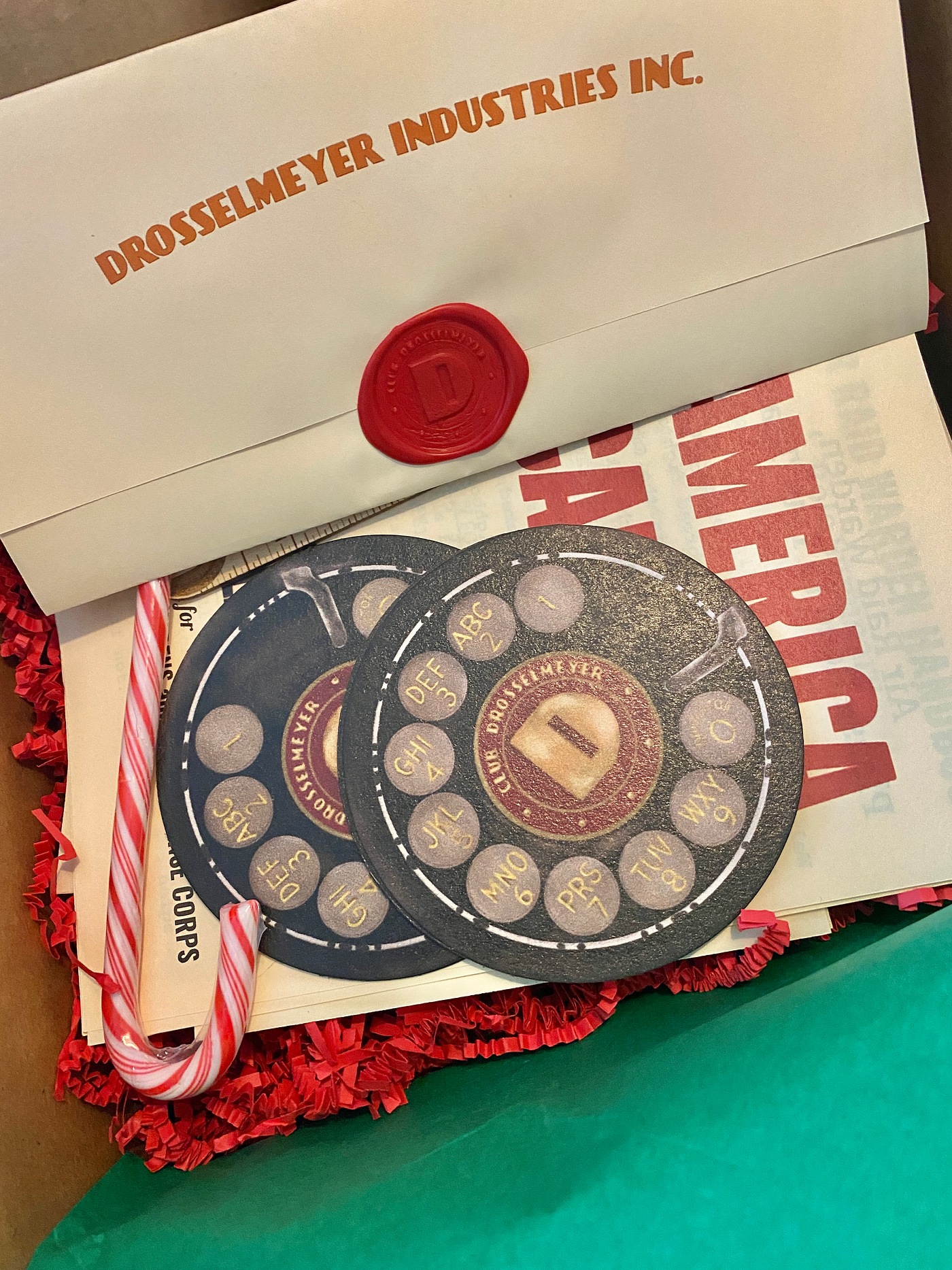
As for the puzzles themselves, as a recipient of a Drosselbox, I would remiss not to point out the level of thought and care that went into the box I received. Most of the items were paper-based but quite nicely printed. I really appreciated the adorable pins for the individual player roles, the custom Drosselmeyer coasters, the Drosselmeyer mechanical pencil, the Drosselmeyer ruler, and — of course — the requisite candy cane. (This is a holiday show, after all.) Plus: I was glad that I didn’t have to print all of these things out. This was advantageous with a few puzzles where having the materials at exactly the correct scale was necessary to solve them (one of our players sadly discovered during the game that she must have printed some things out at the wrong size).
However, it was a little tough to share progress over Zoom for these paper-based puzzles. In particular, we struggled during a difficult puzzle that involved overlapping pieces of cardboard onto a flat surface. There was no way to hold the pieces of cardboard up to the camera to show each other what we thought was working and keep their vertical order intact. And our own Blake Weil attempted to tip over over his laptop to show off the status of his solution, but instead, we mostly got “finger cam” on our end. (Hilarious, but perhaps not what the designers intended.) A few sealed items were also marked as “not a puzzle” only after being opened, which felt like unnecessary distractions to the main goal as well.
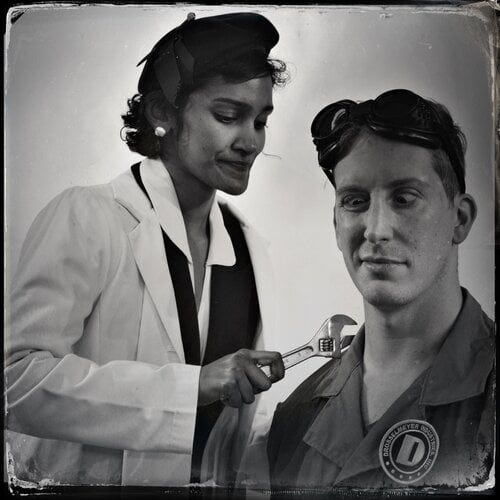
The wildly ambitious Club Drosselmeyer 1943 tries to be a lot of things all at once to a lot of different people; I’m told that’s part of what makes the IRL experience so enjoyable. But there’s a big difference between doing an in-person puzzle adventure where you can customize your level of engagement and sit back on occasion in a room of 150 people versus a remote game meant for small teams working together over Zoom. The pathways a remote team ends up taking are, for the most part, linear. The Club Drosselmeyer 1943 phone tree only seemed to allow for binary decision making, i.e., press “1” to fight the Nazis, press “2” to help them. Solutions to puzzles were only accepted by the underlying engine if perfectly entered. It’s difficult to divide and conquer when one person is in charge of making the phone calls and managing the radio player at the same time. And while we enjoyed the story’s twists and turns along the way, having our custom ending delivered via the radio broadcast felt a little flat after having interactions with actors on the phone, though it makes sense for scaling purposes.
Overall, I do wish the Drosselmeyer experience could be streamlined and simplified a bit; the underlying concepts and game engine are great, but the logistics of having four separate but interconnected parts (paper, Zoom, telephone, radio show) too often got in the way of having fun. To be honest, the entire experience would have been a lot easier if we’d simply all been in the same room with one another rather than playing over Zoom.
But for people who are eager to engage with some challenging puzzles, who feel fine with going over the allotted time limit on purpose (thankfully, the game doesn’t actually boot you out at the two hour mark), and who don’t mind the absence of live performers, there’s still a lot to appreciate in Club Drosselmeyer 1943 in the weeks to come. The automated radio and phone elements will be online through the end of 2021, so the game remains playable for many months to come.
So: my advice to future participants? Set aside a good three hours (with breaks) to play. And do trade off who has to be Air Raid Warden/radio control.
While the live show is over, Club Drosselmeyer 1943 is still available to print-and-play or have shipped to your home. The experience costs $35 and up.
Discover the latest immersive events, festivals, workshops, and more at our new site EVERYTHING IMMERSIVE, new home of NoPro’s show listings.
NoPro is a labor of love made possible by our generous Patreon backers. Join them today!
In addition to the No Proscenium web site, our podcast, and our newsletters, you can find NoPro on Twitter, Facebook, YouTube, Instagram, in the Facebook community Everything Immersive, and on our Slack forum.
Office facilities provided by Thymele Arts, in Los Angeles, CA.




















Discussion